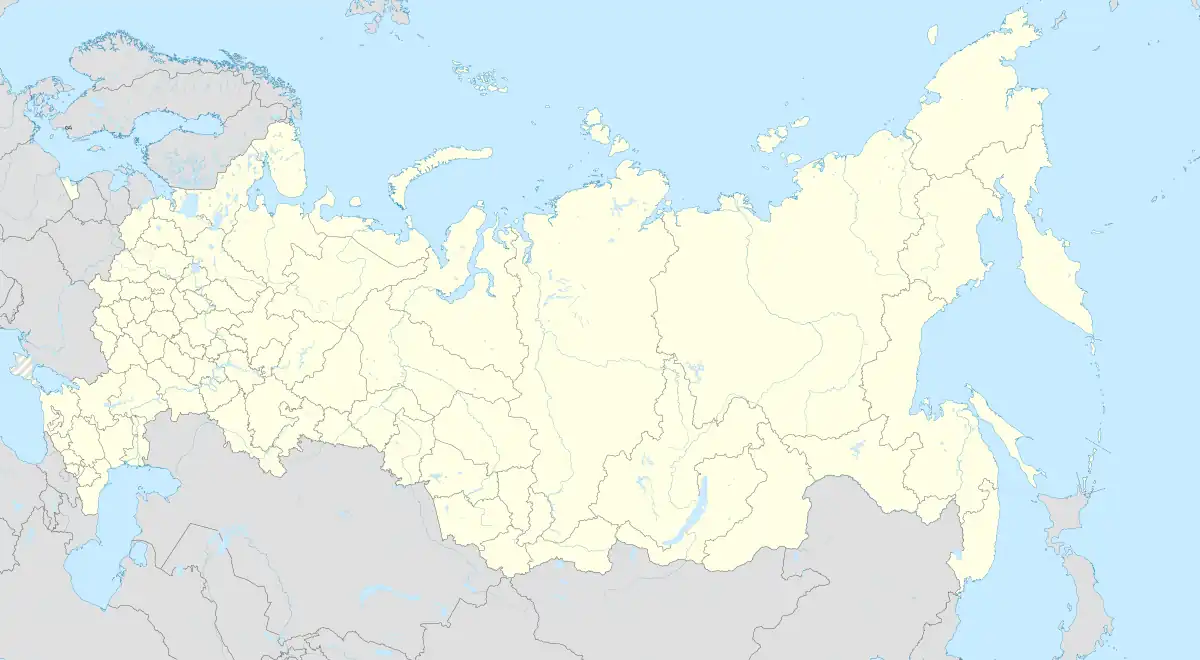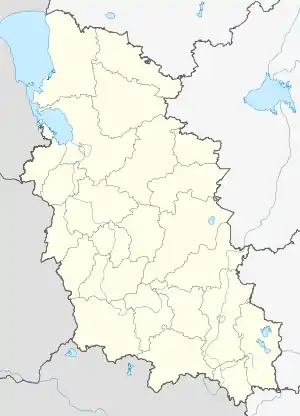Loknya, Pskov Oblast
Loknya (Russian: Локня) is an urban locality (a work settlement) and the administrative center of Loknyansky District of Pskov Oblast, Russia. Municipally, it is incorporated as Loknya Urban Settlement, the only urban settlement in the district. Population: 3,872 (2010 Census);[4] 4,898 (2002 Census);[8] 6,061 (1989 Census).[9]
Loknya
Локня | |
|---|---|
Work settlement[1] | |
Location of Loknya | |
 Loknya Location of Loknya  Loknya Loknya (Pskov Oblast) | |
| Coordinates: 56°50′N 30°09′E | |
| Country | Russia |
| Federal subject | Pskov Oblast |
| Administrative district | Loknyansky District[2] |
| Founded | 1901[3] |
| Population | |
| • Total | 3,872 |
| • Estimate (2018)[5] | 3,421 (−11.6%) |
| • Capital of | Loknyansky District[2] |
| • Municipal district | Loknyansky Municipal District[1] |
| • Urban settlement | Loknya[1] |
| • Capital of | Loknyansky Municipal District, Loknya Urban Settlement[1] |
| Time zone | UTC+3 (MSK |
| Postal code(s)[7] | 182900 |
| OKTMO ID | 58618151051 |
History
The area was populated since medieval times and was located on the waterways which connected Novgorod and Pskov with Velikiye Luki. In the 15th century, the pogost of Vlitsy was founded, which later became a part of Loknya. In the 15th century, the area was annexed by the Grand Duchy of Moscow.[3] In the course of the administrative reform carried out in 1708 by Peter the Great, it was included into Ingermanland Governorate (known since 1710 as Saint Petersburg Governorate). In 1727, separate Novgorod Governorate was split off, and in 1772, Pskov Governorate (which between 1777 and 1796 existed as Pskov Viceroyalty) was established. The area was a part of Velikoluksky Uyezd of Pskov Governorate.
Loknya was founded in 1900 as a settlement serving the railway station on the railway between Moscow and Riga. Eventually, it became the administrative center of Loknyanskaya Volost of Velikoluksky Uyezd. The name of the station originates from the nearby Loknya River.[3]
On August 1, 1927, the uyezds were abolished, and Loknyansky District was established, with the administrative center in Loknya. The governorates were abolished as well, and the district became a part of Velikiye Luki Okrug of Leningrad Oblast. On June 17, 1929, the district was transferred to Western Oblast. On July 23, 1930, the okrugs were also abolished and the districts were directly subordinated to the oblast. On January 29, 1935, Western Oblast was abolished, and the district was transferred to Kalinin Oblast, and on February 5 of the same year, Loknyansky District became a part of Velikiye Luki Okrug of Kalinin Oblast, one of the okrugs abutting the state boundaries of the Soviet Union. On May 11, 1937, the district was transferred to Opochka Okrug. On May 4, 1938, the district was subordinated directly to the oblast. Between 1941 and 1944, Loknya was occupied by German troops. On August 22, 1944, the district was transferred to newly established Velikiye Luki Oblast. On October 2, 1957, Velikiye Luki Oblast was abolished and Loknyansky District was transferred to Pskov Oblast. The district was abolished on February 1, 1963, and re-established on January 12, 1965.[10]
Economy
Industry
Loknya contains enterprises of timber and food industries, the biggest being the bakery.[11]
Transportation
Loknya is a railway station on the railway connecting St. Petersburg and Vitebsk. It is connected by roads with Bezhanitsy (with access to Porkhov and Novorzhev), with Kholm, and with Velikiye Luki. There are also local roads.
Culture and recreation
Loknya has one building, the Transfiguration Church of the beginning of the 18th century, which is classified as cultural and historical heritage of local significance.[12]
References
Notes
- Law #420-oz
- Государственный комитет Российской Федерации по статистике. Комитет Российской Федерации по стандартизации, метрологии и сертификации. №ОК 019-95 1 января 1997 г. «Общероссийский классификатор объектов административно-территориального деления. Код 58 218 551 001», в ред. изменения №278/2015 от 1 января 2016 г.. (State Statistics Committee of the Russian Federation. Committee of the Russian Federation on Standardization, Metrology, and Certification. #OK 019-95 January 1, 1997 Russian Classification of Objects of Administrative Division (OKATO). Code 58 218 551 001, as amended by the Amendment #278/2015 of January 1, 2016. ).
- История района (in Russian). Портал муниципальных образований Псковской области. Retrieved September 13, 2012.
- Russian Federal State Statistics Service (2011). Всероссийская перепись населения 2010 года. Том 1 [2010 All-Russian Population Census, vol. 1]. Всероссийская перепись населения 2010 года [2010 All-Russia Population Census] (in Russian). Federal State Statistics Service.
- "26. Численность постоянного населения Российской Федерации по муниципальным образованиям на 1 января 2018 года". Federal State Statistics Service. Retrieved January 23, 2019.
- "Об исчислении времени". Официальный интернет-портал правовой информации (in Russian). June 3, 2011. Retrieved January 19, 2019.
- Почта России. Информационно-вычислительный центр ОАСУ РПО. (Russian Post). Поиск объектов почтовой связи (Postal Objects Search) (in Russian)
- Russian Federal State Statistics Service (May 21, 2004). Численность населения России, субъектов Российской Федерации в составе федеральных округов, районов, городских поселений, сельских населённых пунктов – районных центров и сельских населённых пунктов с населением 3 тысячи и более человек [Population of Russia, Its Federal Districts, Federal Subjects, Districts, Urban Localities, Rural Localities—Administrative Centers, and Rural Localities with Population of Over 3,000] (XLS). Всероссийская перепись населения 2002 года [All-Russia Population Census of 2002] (in Russian).
- Всесоюзная перепись населения 1989 г. Численность наличного населения союзных и автономных республик, автономных областей и округов, краёв, областей, районов, городских поселений и сёл-райцентров [All Union Population Census of 1989: Present Population of Union and Autonomous Republics, Autonomous Oblasts and Okrugs, Krais, Oblasts, Districts, Urban Settlements, and Villages Serving as District Administrative Centers]. Всесоюзная перепись населения 1989 года [All-Union Population Census of 1989] (in Russian). Институт демографии Национального исследовательского университета: Высшая школа экономики [Institute of Demography at the National Research University: Higher School of Economics]. 1989 – via Demoscope Weekly.
- Герасимёнок, Т. Е.; Н. В. Коломыцева, И. С. Пожидаев, С. М. Фёдоров, К. И. Карпов (2002). Территориальное деление Псковской области (in Russian). Pskov. ISBN 5-94542-031-X.
{{cite book}}: CS1 maint: location missing publisher (link) CS1 maint: multiple names: authors list (link) - Экономика (in Russian). Портал муниципальных образований Псковской области. Retrieved September 11, 2012.
- Памятники истории и культуры народов Российской Федерации (in Russian). Russian Ministry of Culture. Retrieved June 2, 2016.
Sources
- Псковское областное Собрание депутатов. Закон №833-оз от 5 февраля 2009 г. «Об административно-территориальном устройстве Псковской области». Вступил в силу со дня официального опубликования. Опубликован: "Псковская правда", №20, 10 февраля 2009 г. (Pskov Oblast Council of Deputies. Law #833-oz of February 5, 2009 On the Administrative-Territorial Structure of Pskov Oblast. Effective as of the official publication date.).
- Псковское областное Собрание депутатов. Закон №420-оз от 28 февраля 2005 г. «Об установлении границ и статусе вновь образуемых муниципальных образований на территории Псковской области», в ред. Закона №1542-ОЗ от 5 июня 2015 г. «О внесении изменений в Закон Псковской области "Об установлении границ и статусе вновь образуемых муниципальных образований на территории Псковской области"». Вступил в силу со дня официального опубликования. Опубликован: "Псковская правда", №41–43, №44–46, №49–51, 4 марта 2005 г., 5 марта 2005 г., 11 марта 2005 г. (Pskov Oblast Council of Deputies. Law #420-oz of February 28, 2005 On Establishing the Borders and the Status of the Newly Formed Municipal Formations on the Territory of Pskov Oblast, as amended by the Law #1542-OZ of June 5, 2015 On Amending the Law of Pskov Oblast "On Establishing the Borders and the Status of the Newly Formed Municipal Formations on the Territory of Pskov Oblast". Effective as of the official publication date.).